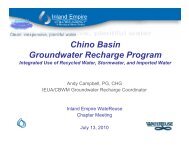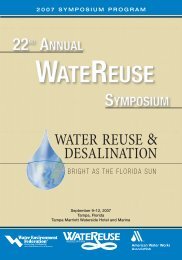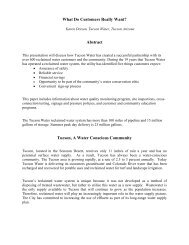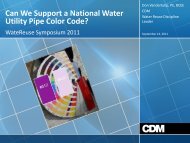Desalination Plant Intakes - WateReuse Association
Desalination Plant Intakes - WateReuse Association
Desalination Plant Intakes - WateReuse Association
You also want an ePaper? Increase the reach of your titles
YUMPU automatically turns print PDFs into web optimized ePapers that Google loves.
The tested wedgewire screen had 2.0 mm of slot openings and was constructed of copper-nickelalloy. The diameter of the screen was 8-5/8 inches; the overall screen length was 35 inches; andthe outer flange was 6-5/8 inches. Seawater was pumped from a depth of 15 to 20 feet beneaththe sea surface.Source: Tenera EnvironmentalFigure 7 – Wedgewire Screen Used in Santa Cruz I&E StudyThe results of this comprehensive I&E study indicate that:• No endangered, threatened, or listed species were entrained.• At an average intake velocity of 0.33 fps, the screen was successful in completelyeliminating impingement.• The wedgewire prevented entrainment of adult and juvenile fish species.• The greatest projected proportional mortality that could be attributed to the screenoperation for the top 80% of the fish larvae in the source water area at 7.0 MGD intakeflow was 0.06%.• The greatest projected proportional mortality for the caridean shrimp and cancrid crablarvae in the source water area for 7.0 MGD intake flow was 0.02%.• The extremely low proportional losses of fish, shrimp and crab populations indicate thatthe full-scale wedgewire intake screen operation at 7.0 MGD will not cause significantSeawater <strong>Desalination</strong> <strong>Plant</strong> <strong>Intakes</strong> – Impingement and Entrainment Page 12
















